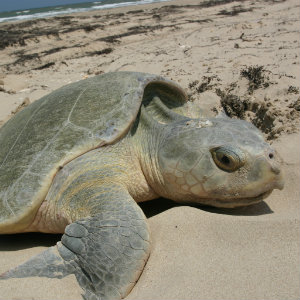KEMP'S RIDLEY SEA TURTLE

Selina Heppell
Latin name: Lepidochelys kempii
The Kemp's ridley sea turtle nests only in the Gulf of Mexico and was nearly lost in the 1980s due to overharvest of eggs and incidental drowning in fishing nets. Only about 300 females nested in 1985. The species has rebounded through an intensive bi-national effort in the U.S. and Mexico. Dr. Selina Heppell has worked with Kemp's ridley researchers since 1992, contributing an assessment model to estimate population size and time to recovery from impacts like the Deep Water Horizon oil spill.
Did you know? The Kemp's ridley is the smallest sea turtle and the only species to nest regularly in the daytime. The species is recovering from near extinction thanks to intensive conservation efforts by Mexico and the U.S. They are threatened by oil spills, beach development and accidental capture in fisheries
Recovery plan More information
Publications:
Crowder, LB and SS Heppell. 2011. The decline and rise of a sea turtle: how Kemp’s ridleys are recovering in the Gulf of Mexico. Solutions 2:67-73. http://www.thesolutionsjournal.com/node/859
Heppell, S. S., P. Burchfield, and J. Peña. 2007. Kemp’s ridley recovery: how far have we come, and where are we headed? Pp. 325-335 in P. Plotkin, ed. Biology and Conservation of Ridley Sea Turtles. Johns Hopkins University Press, Baltimore.
Heppell, S. S., D. Crouse, L. Crowder, S. Epperly, W. Gabriel, T. Henwood and R. Marquez. 2005. A population model to estimate recovery time, population size and management impacts on Kemp’s ridley sea turtles. Chelonian Conservation and Biology 4:761-766.
Heppell, S. S. and L. B. Crowder. 1998. Prognostic evaluation of enhancement programs using population models and life history analysis. Bulletin of Marine Science 62:495-507.
Turtle Expert Working Group. 2000. Assessment update for the Kemp’s ridley and loggerhead sea turtle populations in the Western North Atlantic. U.S. Department of Commerce NOAA Technical Memorandum NMFS-SEFSC-444, 115 pp.
